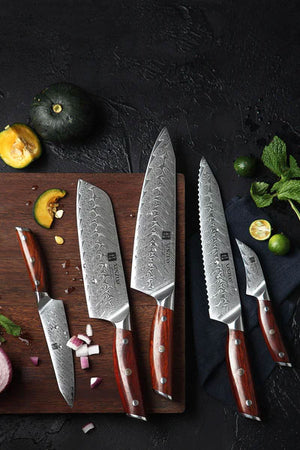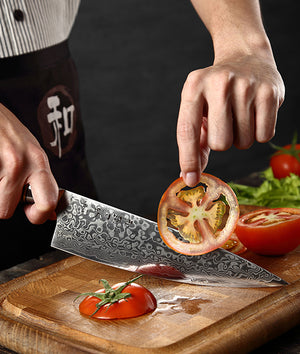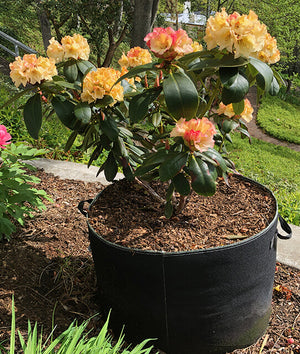
This Vs. That: Santoku Knife Vs. Chef Knife
Making sure you have the right tools and equipment in your kitchen is an essential part of not only being able to cook effectively and efficiently, but most of all, to be able to enjoy the process. That means, pots, pans, but most importantly, knives.
Now, if you could have absolutely anything you wanted, you’d probably, most likely, choose to have every single type of knife in your kitchen. However, for most people, that’s not the reality, and that’s why it’s so handy to have a knife that’s versatile. Although honestly, having a versatile knife that can do just about anything is handy even if you do have absolutely everything in your kitchen!
And that’s what both the chef’s knife and santoku knife are known for – versatility.
However, having said that, just because they’re known for their versatility doesn’t mean that they’re the same – they certainly aren’t. On the most basic level, a Santoku knife is a Japanese-style knife, while a chef’s knife adopts more western style and design. But there’s a lot more to it than that!
We’re going to do a full comparison of Santoku vs. chef knives so that you know exactly what each one is, as well as what their similarities and differences are. That way, you’ll be all ready and set to purchase one of the two that best suits your needs – or both!
Stick around while we do a comprehensive this versus that – Santoku vs. chef knife edition.
What is a Santoku Knife?
As we already mentioned, a Santoku knife is a Japanese-style, multipurpose kitchen knife that is known in particular for its versatility. Its blade is about medium length and fairly wide, and it has a pretty flat cutting edge, making for a fairly unique shape. It can be used for just about anything – that is, cutting, slicing, dicing, and so forth – other than things that are particularly tough like bone or cartilage.
The word “Santoku” actually translates to “three virtues”, which is a reference to the knife’s versatility and ability to be able to work with meat, vegetables, and fish too, which is something that not many knives can do.
Most Important Features of a Santoku Knife
As we’ve already noted, versatility is probably the standout feature of the Santoku knife, but let’s have a closer look at the specific components of the knife that make this possible.
- Blade Design: The blades are normally shorter and a bit wider than normal, and the edge tends to be flat. This makes it ideal for straight up-and-down chopping.
- Edge Retention: Because top-quality Santoku knives are made from great materials (like high-carbon stainless steel), they tend to boast excellent edge retention, meaning that they stay sharp, don’t need to be sharpened very often, and, consequently, have an overall longer lifespan.
- Balance: Santoku knives tend to have good weight distribution between the blade and the handle, which allows for improved control and it reduces fatigue during prolonged use.
- Blade Thickness: As is a signature feature of most Japanese-style knives, Santoku knives tend to have fairly thin blades compared to Western-style knives. This allows for impeccable precision.
- Non-Stick Coating: Some (not all) Santoku knives are coated with a non-stick material so that the food you’re cutting doesn’t get stuck to the blade.
- Blade Material: Santoku knives tend to be made from high-quality materials such as a high-carbon stainless steel. This is ideal because it contributes to the knife’s strength and durability from a carbon perspective, and the stainless steel contributes resistance to corrosion.
What Can a Santoku Knife Be Used For?
We know that a Santoku knife can be used with meat, fish, and vegetables – also known as the “three virtues” – but what exactly can it do?
Here’s exactly what a Santoku knife can do:
- Chopping: The shape of the blade (including its length and width) make it ideal for efficient up-and-down chopping motions, which makes it perfect for chopping p herbs, vegetables, and other types of food.
- Dicing: Since the blade is short and wide, it’s great for dicing ingredients into small, uniform pieces.
- Slicing: Since the Santoku knife has a flat edge, it’s good at producing clean and precise slices of fruits, vegetables, and boneless meats.
- Precision Cuts: It may not have a super sharp, pointed tip, but the thinness of the blade allows it to produce precise cuts.
- Mincing: The sharpness and flatness of the blade make it ideal for mincing anything from herbs and garlic to other small ingredients.
- Thin Cuts: As we said when it comes to precision, because of the thin blade, a Santoku knife can cut super thin slices.
What is a Chef’s Knife?
A chef’s knife, commonly referred to as a cook’s knife, is (as we’ve already mentioned) a super versatile kitchen knife made in accordance with western style. It’s normally got a broad, tapered blade and it’s typically pretty long – although these things can vary from one night to the next.
Many people will argue that a chef’s knife ought to be one of the first knives you buy for your kitchen because it really is one of the most useful tools you’ll own, as its design makes it well suited for a plethora or kitchen tasks.
Most Important Features of a Chef Knife
Let’s get down to the details of all the components that make up a chef’s knife.
- Blade Length: It’s known for having a pretty long blade, averaging on about eight to ten inches in length. This is one of the things that contribute significantly to the knife’s versatility.
- Blade Shape: The chef’s knife has curved edge which allows for a rocking motion during chopping – it contributes to precision.
- Blade Tip: The chef’s knife is known for its pointed tip which allows for extra precision, as it helps with piercing and making intricate cuts.
- Edge Sharpness: The edge of the blade tends to be sharpened at an angle to help with both slicing and chopping.
- Tang: A chef’s knife can have either full or partial tang, it depends on price and preference. But, having full tang can make the knife more balanced and durable (and more expensive).
What Can a Chef’s Knife Be Used For?
A chef’s knife can be used for just about anything, other than really hard materials like bone and cartilage. But, here is a more detailed list of exactly what it can (ad should) be used for:
- Chopping: The curved, broad blade makes it good at chopping veggies, herbs, and even meat.
- Slicing: The blade is perfectly fine for slicing meat, veggies, or fruit into uniform slices.
- Dicing: The curved shape of the blade makes it great for using a rocking motion for dicing ingredients into small, uniform pieces.
- Mincing: The sharpness and size of the blade make it great for mincing herbs and garlic effectively.
- Deboning: You shouldn’t use it to cut through bone or cartilage, but you can use a chef knife to debone – that is, cutting the meat around the bone.
- Poultry and Meat Preparation: A chef’s knife can absolutely be used for portioning meat and poultry or filleting fish (although you’d probably rather using something sharper if possible).
- Precision Cuts: The pointed tip contributes to being able to cut precisely, including things like trimming fat and making other intricate cuts.
Similarities Between Santoku Vs. Chef’s Knife
Now that you know what a Santoku knife is and what it can be used for and what a chef’s knife is and what that can be used for, it’s time to do a direct comparison of the two. The reason this comparison is worth the time and effort is because these two kitchen knives are frequently compared, and sometimes, people even claim that they’re the same – which they most certainly are not!
However, we don’t mean that in a bad way – they’re both great knives that are worth having in your kitchen. But, they’re designed differently and they have different purposes. So, there is actually great value in not only having one of the two, but both of them if you’re in a position to do so.
Of course, as we’ve said from the beginning, the main similarity between Santoku and chef’s knives is that they’re both incredibly versatile But, what else makes them so alike?
Here are the most important similarities between a chef’s knife and a Santoku knife:
- Long Blade: The blades of these two knives might not be exactly the same length, but both chef’s knives and Santoku knives are known for having fairly long blades.
- Versatility in Use: Both knives can be used for various types of cutting tasks, including cutting, chopping, slicing, and dicing; and, they can both be used for vegetables, meat, and fish. Neither of them should be used on bone or cartilage!
- Blade Material: Santoku and chef’s knives can both potentially be made from a variety of materials depending on your preference, including stainless steel, high-carbon steel, and other things too.
- Handle: The main priority in the design of the handle is comfort and secure grip, so both handles are all about ergonomics – this allows for use over an extended period of time.
- Weight: Both knives are known for their balanced weight distribution, although there can always be variations in the specific weights of knives, depending on personal preference.
- Edge: They both have a flat cutting edge, albeit to different degrees.
Differences Between Chef Knife Vs. Santoku
Clearly, these two knives are pretty similar, even though there can be plenty of variations from one design to the next.
However, as we made very clear earlier, they may be similar, but they’re definitely not the same. Just because they’re both versatile and can be used for many of the same tasks, that doesn’t mean they ought to be seen as identical kitchen knives.
Here are the main and most important differences between a Santoku knife vs. chef:
- Length: They’re both fairly long as far as kitchen knives go, but the chef’s knife is certainly longer than the Santoku. The former is normally between eight and 12 inches long, while Santoku knives tend to be around seven or eight inches long.
- Thickness: Much like other Japanese knives, the blade of a Santoku knife is fairly thin, while the blade of a chef’s knife is thicker.
- Tip: A Santoku knife has a curved tip, while a chef’s knife has a sharp, pointed tip.
- Shape: The shape of the two knife blades differs quite a lot – the Santoku is a sheepsfoot shape that curves downwards, while the chef’s knife has a curved belly.
- Functionality: A chef’s knife is ideal for a rocking motion when cutting food, while a Santoku knife is better suited to chopping.
- Width: The Santoku knife blade is narrower than that of the chef’s knife.
- Origin of Design: The Santoku knife is of Japanese origin, while a typical chef’s knife is a western design.
Clearly, while there may be lots of similarities between these two knives, there are also plenty of differences – the devil really is in the details.
Final Thoughts on This Vs. That: Chef’s Knife Vs. Santoku
There you have it – the ultimate comparison between a chef’s knife and a Santoku knife. While they’re both incredibly versatile knives, there are several differences between the designs of the two knives (especially their blades) that make them well suited to specific tasks.
So, if you’re looking to buy only one of the two, now you know exactly what the difference is between the two. But, ultimately, if you’re in a position to invest in both, we’d absolutely suggest doing that, because they both have the potential to add a lot to your kitchen.


